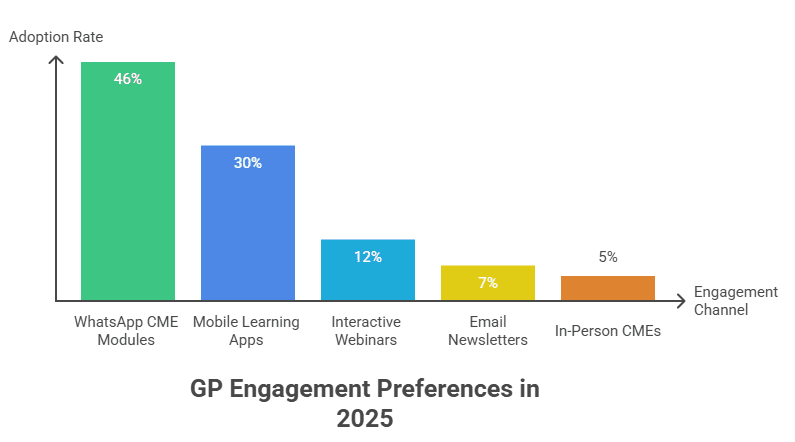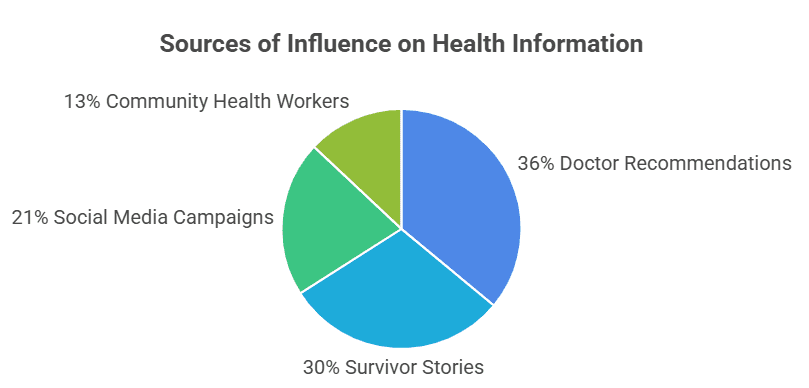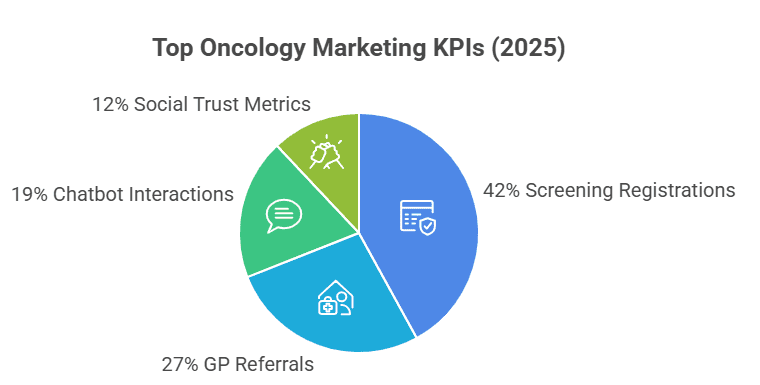Introduction: A Human-Centered Shift in Oncology Marketing
In 2025, oncology marketing is no longer about broadcasting drug benefits—it’s about starting meaningful conversations. With precision medicine, AI tools, and targeted therapies reshaping cancer care, pharma must adapt by building trust, dialogue, and genuine patient support.
The shift is from promotion to partnership, where campaigns serve as bridges between pharma, oncologists, patients, and caregivers. The goal is not just awareness, but better outcomes and stronger communities.
This evolution highlights how marketing is becoming an active participant in healthcare delivery. By aligning strategies with real-world patient journeys, pharma transforms campaigns into life-saving interventions.
1. Patients as Co-Creators of Campaigns
Patients are no longer passive recipients of information. Pharma now involves them as co-creators, shaping campaigns around real fears, stories, and aspirations. This collaborative approach makes marketing authentic and impactful.
By giving patients a voice in campaign design, pharma creates content that feels relatable and human-centered. This builds trust and fosters long-term engagement beyond a single interaction.
2. Precision Data for Smarter Segmentation
Cancer varies by geography, lifestyle, and demography. AI-powered segmentation enables pharma to tailor messages for each group—from urban breast cancer campaigns to rural oral cancer outreach—ensuring relevance.
This guarantees the effective use of marketing resources, delivering the appropriate message to the correct audience. It also helps campaigns address unique cultural and socioeconomic realities that influence care.
3. General Practitioners: The Referral Backbone
GPs remain the frontline identifiers of potential cancer symptoms. Pharma now supports them with bite-sized CME modules, quick diagnostic guides, and referral incentives.

By strengthening GPs, pharma ensures earlier cancer detection across communities. These efforts transform everyday consultations into life-saving opportunities for referral and screening.
4. Omnichannel Consistency for Oncologists
From email digests to AI-powered dashboards, oncologists expect seamless communication across platforms. Pharma ensures that messages are consistent, concise, and clinically relevant across every channel.
This creates a smooth information flow that reduces confusion and increases credibility. By meeting oncologists where they are, pharma proves itself as a trusted partner in clinical practice.
5. Behavioral Nudges for Patient Engagement
Subtle nudges like SMS reminders, gamified health challenges, or digital rewards motivate patients to attend screenings. These behavioral strategies turn awareness into action.
Without putting any pressure on them, they advise patients to take preventative measures. Nudges work best when integrated into daily life, making healthcare choices habitual rather than exceptional.
6. Survivor Stories as Campaign Anchors
Survivor-led storytelling remains the most emotionally powerful driver of patient engagement. Campaigns that feature real journeys achieve far higher trust and impact than generic awareness ads.
These tales dispel stigma and demonstrate the possibility of healing. By humanizing cancer care, survivor voices encourage patients to take proactive steps earlier.
7. AI-Driven Personalization of Campaigns
AI curates patient journeys by delivering personalized content. A smoker may receive oral cancer screening alerts, while a woman researching lumps may be guided toward breast cancer checkups.

This personalization ensures patients don’t feel like just another number. By tailoring messaging, pharma enhances both relevance and trust in its outreach efforts.
8. Vernacular Messaging for Regional Impact
Campaigns resonate more when delivered in local languages and cultural formats—from folk theater in villages to regional radio shows. This cultural adaptation breaks barriers of trust and literacy.
It demonstrates respect for local traditions, which strengthens community buy-in. Oncology commercials feel inclusive and truly accessible because to regionalized messaging.
9. Digital Ecosystems for Oncology Specialists
Pharma companies are building integrated digital platforms with research updates, treatment trackers, and peer discussion tools. These platforms shift pharma from a supplier role to a knowledge partner.
Such tools reduce the time oncologists spend searching for updates. They provide one-stop solutions that enhance efficiency, reinforcing pharma’s role as a valuable clinical ally.
10. New KPIs That Reflect Real Impact
Oncology marketing success is measured not by clicks, but by screenings booked, referrals made, and survivors supported.

These KPIs bring marketing closer to healthcare outcomes. They shift the focus from vanity metrics to impactful measures of awareness, detection, and patient empowerment.
11. Micro-Influencers in Healthcare
Regional doctors, nurses, and community leaders often have deeper trust networks than national figures. Pharma leverages them to spread cancer awareness authentically.
These micro-influencers are embedded in their communities and speak the language of everyday patients. Their recommendations feel personal rather than promotional, increasing receptivity. By partnering with local voices, pharma ensures outreach becomes a community-led initiative, not a corporate message. Such collaborations also help address cultural sensitivities that larger campaigns might overlook.
12. Predictive Analytics for Proactive Outreach
By monitoring online searches and health data, AI predicts where cancer awareness campaigns are most needed. This allows real-time deployment of local micro-campaigns.
Predictive analytics turns marketing into an early-warning system for public health. Campaigns can be customized to address spikes in specific cancer symptoms in particular regions. This proactive approach saves time, resources, and lives by ensuring help arrives before demand peaks. In many ways, predictive outreach transforms pharma into a front-line health partner.
13. Gamified Tools for Patients
Pharma-backed mobile apps now use health scores, badges, and community challenges to encourage screenings. Gamification makes participation enjoyable and habit-forming.
This strategy reduces the intimidation often associated with medical messaging. Patients feel rewarded rather than lectured, increasing compliance with preventive actions. Gamification also creates community-wide momentum, where friends and families encourage each other to participate. Over time, it builds sustainable health behaviors that extend beyond oncology alone.
14. Wearables as Awareness Partners
Smart devices now track vitals and remind users of screenings. Pharma integrates its educational content with wearables, blending lifestyle with prevention.
The continuous data from wearables creates daily engagement opportunities for pharma brands. Instead of one-time campaigns, health prompts become a regular part of a patient’s life. These devices also create a feedback loop for oncologists, providing them with valuable health insights. Ultimately, wearables bring preventive oncology into people’s pockets and wrists, 24/7.
15. Public-Private Partnerships for Scale
Pharma firms co-sponsor cancer awareness drives with health ministries and NGOs. This adds legitimacy, cost-efficiency, and broader reach to campaigns.
Such partnerships bridge the gap between corporate resources and public health priorities. They also ensure that pharma aligns with national strategies rather than working in silos. Co-branding with government institutions increases credibility among skeptical communities. Over time, these partnerships foster sustainable change that outlives individual campaigns.
16. Survivor-Led Digital Communities
Online survivor forums supported by pharma host webinars, Q&A sessions, and peer discussions. These safe spaces offer both medical guidance and emotional support.
Digital communities empower survivors to become role models for others. Their lived experiences create authenticity and empathy that cannot be replicated by corporate campaigns. Pharma benefits from listening to the stories and struggles expressed in these forums. In return, survivors feel valued, turning communities into mutually beneficial ecosystems of trust and learning.
17. Voice Tech for Rural Outreach
Voice bots and IVR helplines deliver oncology knowledge in local dialects. This ensures that even those with low literacy or poor internet access can receive cancer education.
Voice-based campaigns are particularly effective in rural and semi-urban areas where smartphones are common but literacy remains a challenge. They provide instant, simple, and accurate answers to urgent cancer-related questions. The format also allows for interactive symptom checks, giving patients confidence to seek care. This innovation ensures that no population is excluded from oncology education.
18. Sentiment Analytics for Campaign Refinement
AI scans patient comments and online responses to measure campaign sentiment. If fear dominates, messaging shifts toward reassurance and hope.
Sentiment analytics helps pharma identify emotional gaps in their campaigns. By tracking mood trends, marketers can refine tone, imagery, and delivery. This ensures that outreach never alienates or intimidates patients. Instead, campaigns remain positive, empathetic, and deeply connected to community needs.
19. Survivor-Led Clubs for Grassroots Awareness
Survivor groups conduct local workshops and community screenings, bringing credibility to pharma-backed outreach. Their personal stories break stigma and build confidence.
These clubs act as trusted peer networks that normalize conversations around cancer. They create a ripple effect, encouraging entire communities to prioritize early detection. Pharma sponsorship provides structure and resources, while survivors provide passion and authenticity. Together, they form grassroots movements that inspire lasting behavioral change.
20. AR/VR Tools for Oncologist Training
Immersive AR/VR platforms let oncologists practice rare surgeries or explore tumor biology in 3D. Pharma sponsorship of such training reinforces its role as a partner in education.
These tools make complex procedures easier to understand and replicate. They also democratize learning by offering equal access to training, regardless of geography. Younger oncologists especially find AR/VR an engaging medium for upskilling. Over time, this innovation positions pharma as a leader in medical education and digital innovation.
21. Smart Chatbots for Patient Support
AI-driven chatbots act as 24/7 virtual assistants, guiding patients to screening centers, booking consultations, and answering FAQs in local languages.
Their round-the-clock availability ensures patients never feel abandoned in their care journey. Chatbots are cost-effective yet highly scalable, serving thousands simultaneously. They also collect valuable insights into patient concerns, helping pharma refine campaigns. In the long run, these smart assistants become indispensable tools for patient navigation.
22. Social Listening Against Misinformation
Pharma now monitors and counters myths such as “herbal cures for cancer” through fact-based campaigns and doctor-verified resources.
Social listening tools enable real-time identification of dangerous misinformation. Corrective campaigns can then be launched immediately, often featuring respected medical professionals. This proactive approach helps restore public confidence in evidence-based medicine. In doing so, pharma positions itself as a guardian of truth in an era of misinformation.
23. Survivorship Marketing Beyond Treatment
Pharma extends its engagement into survivorship by offering apps for nutrition, mental health, and rehabilitation, building long-term loyalty among survivors.
These initiatives recognize that the cancer journey does not end with treatment. Survivors need ongoing support to rebuild their lives physically and emotionally. By stepping into this space, pharma provides holistic care beyond medication. This patient-centered vision ensures brands remain trusted partners long after treatment concludes.
24. The Future of Oncology Marketing
Tomorrow’s oncology marketing blends predictive AI, hyper-personalization, and emotional storytelling. It will focus as much on quality of life as on early detection and treatment.
The future will be about anticipating needs before patients even articulate them. Campaigns will become smarter, more empathetic, and deeply tailored to individuals. Pharma companies that master this blend will set industry benchmarks. Ultimately, oncology marketing will evolve into a lifesaving collaboration between science, technology, and humanity.
Conclusion
Pharma marketing in oncology is evolving into a mission-driven discipline. By blending trust, technology, and empathy, campaigns now save lives as much as they inform.
The true success of marketing in 2025 lies not in numbers, but in patients empowered, oncologists supported, and survivors inspired to share hope.
This transformation signifies a deeper role for pharma in public health. By prioritizing outcomes over optics, marketing becomes a catalyst for early detection, timely treatment, and community resilience.
The Oncodoc team is a group of passionate healthcare and marketing professionals dedicated to delivering accurate, engaging, and impactful content. With expertise across medical research, digital strategy, and clinical communication, the team focuses on empowering healthcare professionals and patients alike. Through evidence-based insights and innovative storytelling, Hidoc aims to bridge the gap between medicine and digital engagement, promoting wellness and informed decision-making.



